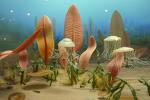 |
 |
 |
 |
 |
Produced
by the Population Genetics and Evolution class, Furman University |
||||
 |
 |
 |
 |
 |
Produced
by the Population Genetics and Evolution class, Furman University |
||||
 |
The
Ediacaran: Charnia |
 |
Charnia species were animals with frond-like body parts. Like other members of the Ediacaran fauna, they florished as atmospheric oxygen levels increased, permitting more complex animals to thrive (Windly 2010). There are very few complete fossils of Charnia around the world, but the majority of the world’s fossils are found in the Avalon Zone of Newfoundland (LaFlamme et al. 2004). Charnia is a member of the Ediacara family, which are the first animals and plants made up of more than one type of cell (Windly 2010). Known for their fragmentary, frond-like bodies,most Charnia species were deep-water, suspension feeders. Although often depicted in fossilized forms as a two dimensional, Charnia actually had many primary layers that overlapped. Three different species of Charnia can be found worldwide; they differ in ratio of length to width and branching pattern (LaFlamme et al. 2007). As time went on, different species of Charnia developed unique feeding strategies, perhaps to reduce competition (LaFlamme et al. 2004). Also, as the species evolved, some went to shallower waters were the current was stronger. Page by Julia Bobo |
 |
| Fossilized Charnia kept at Mistaken Point, Newfoundland, Canada. Photo credit: The Geological Society of London. | |
|
LaFlamme, M., GM Narbonne, C Greentree, and MM Anderson. 2007. Morphology and taphonomy of an Ediacaran frond: Charnia from the Avalon Peninsula of Newfoundland. Geological Society, London, Special Publications 286: 237-257 LaFlamme, M., GM Narbonne, and MM Anderson. 2004. Morphometric analysis of the Ediacaran frond Charniodiscus from the Mistekan Point formation, Newfoundland. Journal of Paleontology 78: 827-837.Windley, BF. 2010. Ediacara fauna. In Encyclopædia Britannica Online. Accessed January 25, 2010. |